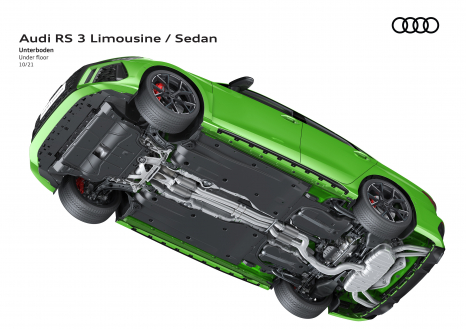Audi RS 3 – Aerodynamics
The design of the new Audi RS 32 is even more dynamic and powerful than that of its predecessor. In the front, the wide RS bumper, the redesigned Singleframe with its distinctive honeycomb grille, and the large air intakes give the compact sports car an expressive appearance.
There is also a new design element behind the front wheel arches: an eye-catching additional air outlet. The rocker panels with black trim have also been redesigned and, in combination with the flared wheel arches, contribute to the expressive look of the new RS 32.
The RS 32 comes standard-equipped with larger and newly developed six-piston steel brakes to keep the power of the five-cylinder engine in check. A ceramic brake system measuring 380 by 38 mm is optionally available on the front axle with a pedal characteristic curve specially adapted to the brake booster. The high-performance brake system weighs another ten kilograms less than the steel brake. Its internally ventilated and drilled discs measure 375 by 36 mm at the front and 310 by 22 mm at the rear. This makes them larger and more stable than in the previous model. Air control elements improve the brakes’ cooling time by 20 percent. This more quickly reduces peak temperatures during hard braking while pedal feel remains the same. In addition, it also reduces brake pad wear, which are 15 percent larger and copper-free. Those who opt for the ceramic brakes can choose between gray, red, or blue brake calipers. Those who prefer the steel version can order red calipers instead of the black ones.
2. Combined fuel consumption in l/100 km: 8.8 – 8.2 (26.7 – 28.7 US mpg); Combined CO2 emissions in g/km: 201 – 188 (323.5 – 302.6 g/mi)
3. Audi RS 3 Sportback:Combined fuel consumption in l/100 km: 8.8 – 8.3 (26.7 – 28.3 US mpg); Combined CO2 emissions in g/km: 201 – 190 (323.5 – 305.8 g/mi)
4. Audi RS 3 Sedan:Combined fuel consumption in l/100 km: 8.7 – 8.2 (27.0 – 28.7 US mpg);Combined CO2 emissions in g/km: 198 – 188 (318.7 – 302.6 g/mi)
Information on fuel/power consumption and CO2 emissions in ranges depending on the chosen equipment level of the car.
10/2021
